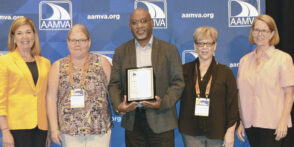Out with the Old
The Maryland MVA updated an old software system and won an AAMVA award in the process
Replacing a 40-year-old software system would be a daunting task under any circumstances, but not only did the Maryland MVA do exactly that, they launched it in a pandemic.
Negash Assefa, director of information technology, described the older COBOL-based system as having “served us well,” but “it was old and unwieldy, and trying to make any change took a significant amount of effort.” Additionally, a driver’s license system, in place since 2003, also needed help.
In either case, making improvements within the system became a massive task, and the decision was made to replace them both. Their efforts earned the Maryland MVA the 2023 AAMVA Trailblazer Award, which is presented to jurisdictions or individuals who implement positive change in their agency and community.
The process of replacing the systems began back in 2015, but after several false starts, the project gained steam again in 2018. With the help of about 45 contractors, the new system, Customer Connect, debuted in early summer 2020. “Our first rollout was in the middle of the pandemic, when everybody was virtual,” Assefa says. “That was very challenging.”
Another obstacle was keeping the old system up and running while the new one was implemented, all during a pandemic, essentially doubling the workload. “As our administrator likes to say, it’s hard enough to do this kind of big conversion, and doing it during COVID is that much harder,” Assefa says.
They succeeded in overcoming these issues out of a dedication to improving customer care. “What we wanted to do, at the end of the day, was provide premium customer service, and make our customers’ experience much better than it had been. Unfortunately, MVAs or DMVs are known for being slow, and having long wait times. We really wanted to change that image,” he says.
The change with the new system has been substantial. In 2012, the target wait time was 40 minutes. The average wait time now is in the single digits. “The modernization has helped significantly improve our customer experience,” Assefa says. “They’re in and out of the office. In fact, we still see customers coming in with a book to read or laptop to work while they wait. And when their number is called, you can see the utter shock on their faces.”
While this is, of course, a significant improvement for the customer, it also helps the staff. First, because the system is more flexible and instinctive than its predecessors. And second, because improved experience for customers directly translates to an easier workday for the staff.
Assefa points out that the process of upgrading the system relied heavily on the involvement of the business side. “We wanted the business to lead this effort, to make all the key decisions as to what the future system was going to be. Of course, IT played a big role, but it was business-led for the entire project.”
The upgrade process that the Maryland MVA undertook, and its success despite significant obstacles, could inspire other MVAs and DMVs to make similar improvements. There are many other legacy systems in place throughout the country, and the process of modernizing is often difficult. However, with the right support, it can be done.
“Replacing a legacy system is a complex process,” Assefa says. “But it’s doable if you have the right people and the right methodology. And we’ve done this, organizationally, because of support from top to bottom. And the message is, it’s hard work but it pays off very handsomely.”




